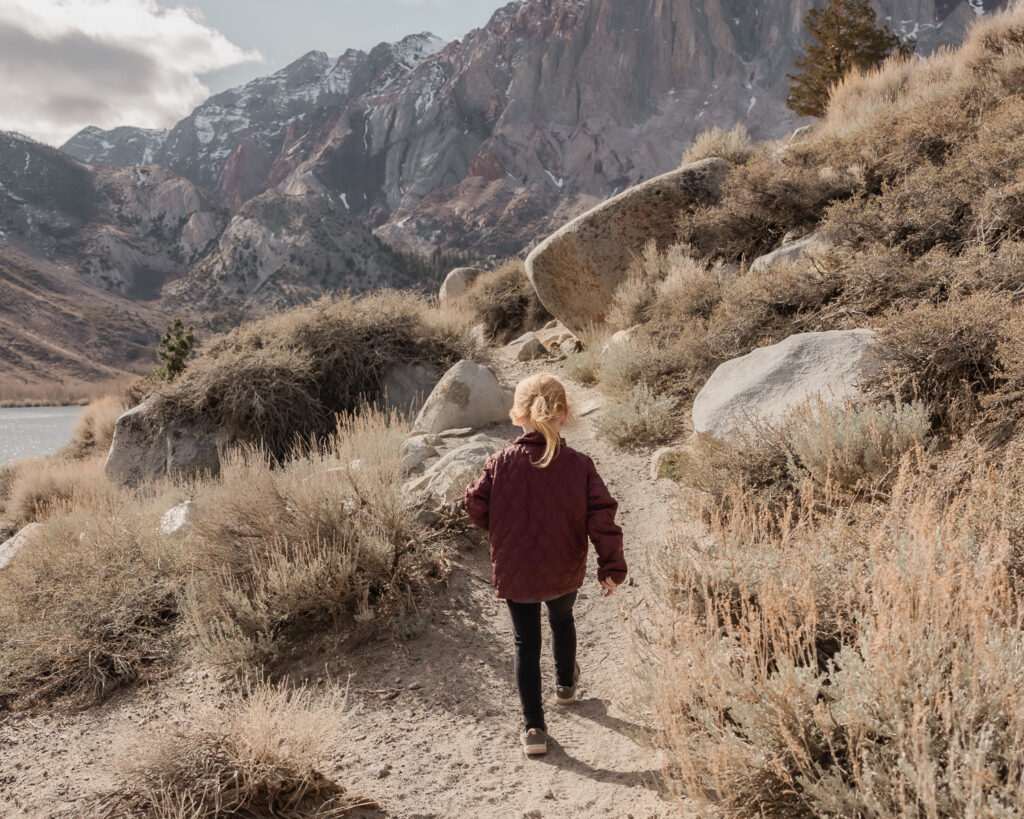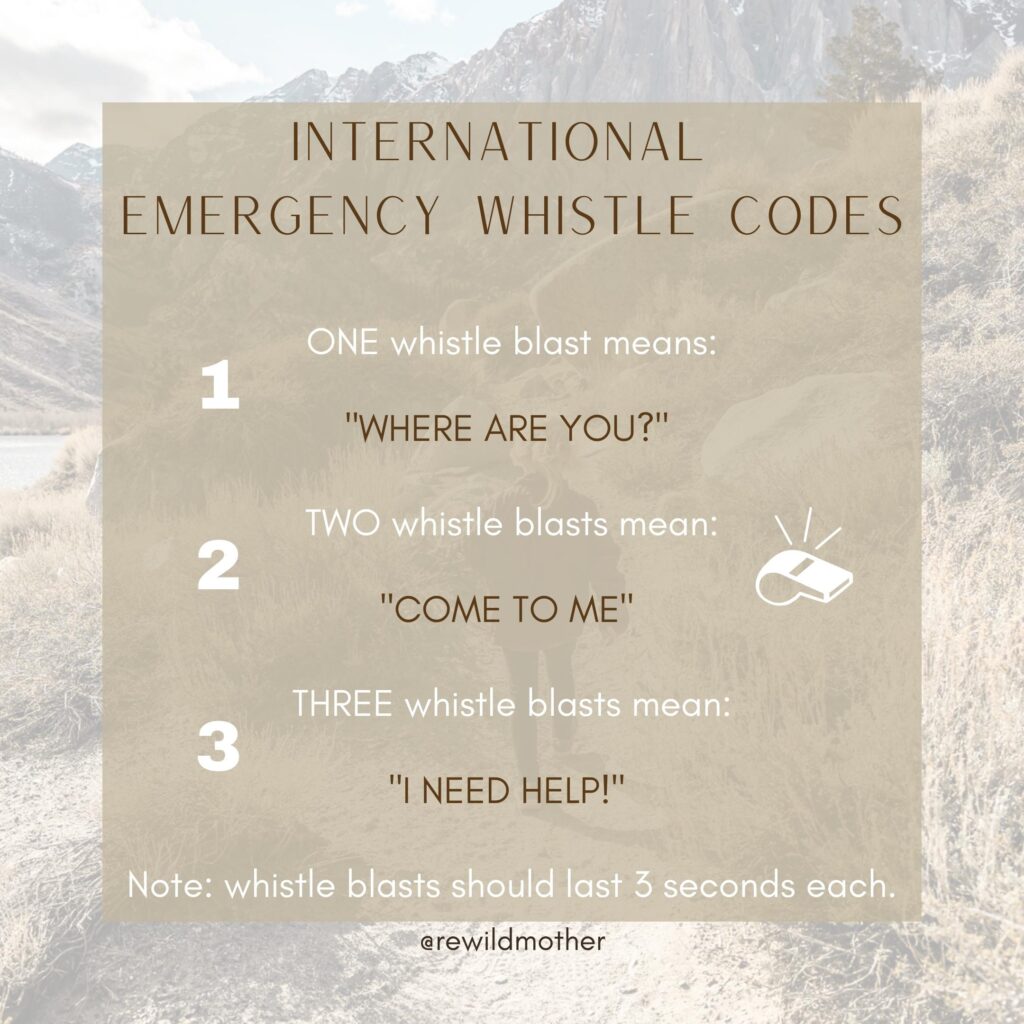
One of the best safety precautions is to teach your kids what to do if they ever found themselves lost on the trail and separated from the group.
Below is the conversation that I have with my almost 7-year-old daughter in the car before every hike. We repeat this info routinely so she has a very clear memory of it. Having this conversation routinely with kids helps them avoid panicking if they become lost and it strengthens their understanding and memory each time.
If you’ve ever wondered:
- What do I teach my child about hike safety?
- What do I do if my child gets lost on a hike?
- How do I use an emergency whistle?
- What are the most important things to teach my child about hiking safely?
then this blog is for you. Welcome!
These are the steps to take that I teach to my child in the event that she gets lost on a hike.
Here is how our conversation goes:
Step 1: FREEZE
Do not keep hiking.
Do not try to find your adult.
I (the adult hiking with you) will come find you.
I will walk back to the last place I saw you and retrace our steps in search of you. If you wandered in a different direction, I will not know to go there first.
Continuing to hike or trying to find your adult could lead to getting more lost and being harder to find.
This is very important: stay where you are!
Step 2: LOOK AROUND AND LISTEN
Can you see me (your adult) in the distance?
Can you hear me?
If YES, shout or blow your whistle to get my attention.
If NO, continue to the steps below.
Do you see anyone that could help you?
Look for a family.
Look for a mom with a stroller or a dad with kids.
Do you feel comfortable talking to anyone you see on the trail? (Tips about talking to other hikers continued below.) If the answer is “No”, continue to Step 3.
Step 3: BLOW YOUR WHISTLE
Blow 3 whistle blasts.
Each whistle blast should last 3 seconds.
The lost hiker blows their whistle 3 times in a row, then waits and listens.
The adult will respond with one whistle blast to let the child know they are coming.
The child is to blow their whistle again, 3 times in a row, then wait for the adult’s response of one whistle blast. This will allow the adult to continue following the sound.
This will continue until the adult and child are within shouting distance and reunited.

Step 4: WAIT FOR YOUR ADULT TO FIND YOU
As the child is waiting for the adult to find them and continuing their back and forth whistle blasts, it is important that the child remembers to STAY WHERE THEY ARE.
Again, do not try to find your adult or follow their whistle sound.
Stay calm. Take deep breaths and remind yourself that your adult is coming to find you.
IMPORTANT REMINDERS:
The lost child may encounter other hikers. It is a good idea to have a conversation beforehand about who they could ask for help from, and who they shouldn’t tell that they are lost. I guide this conversation with my daughter by helping her identify what an ideal, helpful hiker would look like.
Look for a family. Look for a mom with a stroller or a dad with kids.
We can identify a friendly, helpful person by someone who looks prepared to hike. They will have a backpack, hiking shoes, maybe a hat.
Look for a park ranger. Talk about what their uniforms and their vehicles look like. Point out their trucks or take the kids to meet them at a visitor center.
We can also talk about what would be a red flag. Red flags can be: looking unprepared to hike, exhibiting concerning body language, etc. I recommend guiding this conversation with your kids relative to your specific location and mentioning tips in a way that doesn’t make them fearful, but aware instead.
Frequently on hikes with my kids, I will point out certain reminders or tips. If we see a park ranger, I will note what their uniform looked like or comment about the job that they were doing. I’ll also make comments like, “that mom with her kids looked nice. I’d ask her for help if I needed it.” Or, “I felt uncomfortable near that person. I would not ask them for help.” I have conversations like this to help my kids improve their situational awareness and put it into practice.
(Note: I realize that making judgements like the “uncomfortable” comment above could be triggering to some readers. When it comes to my kids safety, I will always err on the side of caution. The fact is, some people are not safe and do not feel comfortable to be around. If my child does not feel safe around someone, I 100% support them in feeling that way, and I do not need an explanation as to why. We can talk about this without being judgmental and rude. Rather, we can honor our gut instincts.)
The location of the hike is another factor to consider. Are you hiking in a National Park where the majority of people are friendly hikers? Or are you on a trail in an urban area that might attract a wide range of people?
Remind the child to notice how they feel. Do they feel comfortable asking someone for help or do they feel cautious at the sight of someone based on their body language?
Remind the child that they DO NOT have to tell anyone that they are lost if they don’t feel comfortable doing so. The adult is coming to find them asap.
It is always a good idea for children to carry their own backpack with water, a snack, and their emergency whistle. You can leave a note inside their pack with your name, phone number, and any other important information you’d like to include.
This teaches them how to be responsible, prepared hikers. It is also very important for them to at least have enough water, should they be separated from you (or their other adult).
I hope this information has helped you gear up to talk with your kids about what to do if they get lost on a hike.
If you are interested in similar hiking safety + preparedness tips, be sure to add your email in the box below so you can get tips straight to your inbox.
xx,
Kaleigh
View comments
+ Leave a comment